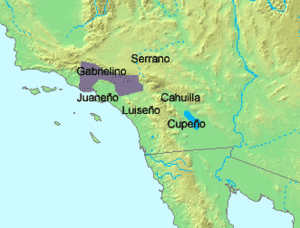Tongva language facts for kids
Quick facts for kids Tongva |
||||
|---|---|---|---|---|
| Gabrielino or Gabrieleño 'eyooshiraaw' |
||||
| Native to | Southern California, United States | |||
| Region | Los Angeles, Santa Catalina Island | |||
| Ethnicity | Tongva | |||
| Extinct | ca. 1900 | |||
| Language family |
Uto-Aztecan
|
|||
| Linguist List | xgf | |||
 |
||||
|
||||
The Tongva language (also known as Gabrielino or Gabrieleño) was once spoken by the Tongva people. They are a Native American group living in and around Los Angeles, California. This language is part of the Uto-Aztecan language family.
The Tongva language has not been used in daily talks since the 1940s. This means it is considered an extinct language. However, some Tongva people are working hard to bring their language back to life. They are using it in everyday conversations and special ceremonies. The language is also taught in classes. It is even used in public talks about important topics like religion and the environment. Tongva is very similar to the Serrano language.
The last people who spoke Tongva fluently lived in the early 1900s. A researcher named John Peabody Harrington wrote down many notes about the language back then. The Smithsonian, with UC Davis, helped organize about 6,000 pages of his notes. A Tongva member spent three years putting these notes into a usable format.
You can still find traces of the Tongva language in the names of places in Southern California. For example, Pacoima, Tujunga, Topanga, and Azusa all have Tongva roots. Even the small planet 50000 Quaoar was named after the Tongva creator god.
Bringing the Language Back to Life
The Tongva language is part of the Takic language group. This group is a branch of the larger Uto-Aztecan family. Since 2012, members of the Tongva tribal council have been working to revive their language. They use old written word lists and compare Tongva to other similar Takic languages. They also offer classes to teach the language.
In 2004, a linguistics professor named Pamela Munro started helping the Tongva people. She taught them about their language at a special workshop. Since then, she has taught monthly Tongva language classes. In these classes, both adults and children learn how to pronounce words. They also learn about grammar, sing songs, and play word games. Professor Munro sees her work as a way to "reclaim" the language.
Professor Munro has created a Tongva dictionary with over 1,000 words. She also runs a Tongva language Facebook page. There, she shares Tongva words, phrases, and songs. Sadly, there are no audio recordings of people speaking the Tongva language. However, there are a few old recordings of Tongva songs on wax cylinders.
Tongva Words You Might Know
Many places in Southern California have names that come from the Tongva language. This is called toponymy. It's a way the language lives on!
Tongva Place Names
Here are some well-known places and their names in Tongva:
| English | Tongva |
|---|---|
| Los Angeles | Yaa |
| San Bernardino | Wa'aach |
| San Gabriel | Shevaa |
| San Pedro | Chaaw |
| Santa Ana | Hotuuk |
| Santa Monica | Kecheek |
| Santa Catalina | Pemu |
Some other place names with Tongva roots include:
- Pacoima: This name comes from the word Pako enter, meaning "the entrance."
- Tujunga: This name comes from the word tux'uu, meaning "old woman." However, some residents say Tujunga means "Mountains of Health."
- Azusa: This name comes from the word -shuuk 'Ashuuksanga, which means "his grandmother."
Numbers in Tongva
Different researchers wrote down Tongva numbers at different times. Here are some examples:
Collected by C. Hart Merriam (1903)
- Po-koo
- Wěh-hā
- Pah-hā
- Wah-chah
- Mah-har
- Pah-vah-hā
- Wah-chah-kav-e-ah
- Wa-ha's-wah-chah
- Mah-ha'hr-kav-e-ah
- Wa-hās-mah-hah'r
- Wa-hā's-mah-hah'r-koi-po-koo
- Wa-hā's-mah-hah'r-koi-wěh-hā
Collected by Alexander Taylor (1860)
- po-koo
- wa-hay
- pa-hey
- wat-sa
- mahar
- pawahe
- wat-sa-kabiya
- wa-hish-watchsa
- mahar-cabearka
- wa-hish-mar
Taylor noted that people did not count past ten at that time.
Collected by Dr. Oscar Loew (1875)
- pu-gu'
- ve-he'
- pa'-hi
- va-tcha'
- maha'r
- pa-va'he
- vatcha'-kabya'
- vehesh-vatcha'
- mahar-kabya'
- vehes-mahar
- puku-hurura
- vehe-hurura
Collected by Charles Wilkes, USN (1838-1842)
- pukū
- wehē
- pāhe
- watsā
Animal Names in Tongva
Here are some animal names recorded by researchers:
- Grizzly bear: hoó-nahr (Merriam), unar (Loew), hundr (Wilkes)
- Black bear: pí-yah-hó-naht (Merriam)
- Desert fox: erow
The Lord's Prayer in Tongva
The Lord's Prayer is called Eyoonak in Tongva. This text comes from old Mission records.
'Eyoonak
'Eyoonak, 'eyooken tokuupanga'e xaa;
hoyuuykoy motwaanyan;
moxariin mokiimen tokuupra;
maay mo'wiishme meyii 'ooxor 'eyaa tokuupar.Hamaare, 'eyoone' maxaare' 'wee taamet,
koy 'oovonre' 'eyoomamaayntar momoohaysh, miyii 'eyaare
'oovonax 'eyoohiino 'eyooyha';
koy xaare' maayn 'iitam momoohaysh,
koy xaa mohuu'esh.
'Wee menee' xaa'e.
Images for kids
-
Mrs. James Rosemeyre (née Narcisa Higuera), photographed here in 1905, was one of the last fluent Tongva speakers. She helped ethnographer C. Hart Merriam learn about the language.


